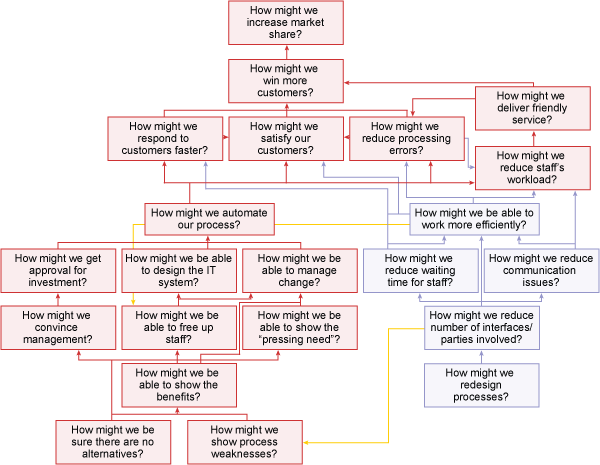
Six Sigma practitioners looking to clarify or explore a task, find root causes of a problem or develop their strategic thinking skills may want to consider using webbing, a valuable exploration tool. Similar to the 5 Whys, this tool encourages practitioners to ask a web of questions about a task or process in order to break down assumptions and find new solutions.
Think Like Spider-Man
One way to understand webbing is to look at Spider-Man. Similar to how this superhero uses webs to move from building to building, practitioners can use webbing to move from question to question, leading to an ever-changing perspective of the world, or process. Webbing can help practitioners better understand why things are the way they are, or to look for a leverage point for future actions. Every question should provide insight into assumptions or details that can help practitioners understand a task more clearly – sometimes more objectively – and reach their target faster and with less effort.
Webbing allows practitioners to make three Spider-Man-like actions:
- Change perspective – By asking “Why?” and “What is stopping you?” practitioners can move from a given position to greater abstraction (more of a visionary, motivating angle) or to a specific position (a more tactical angle).
- Move through time – Timing is always a factor. Where does the motivation or vision come from? What are the past causes? When did they happen? What has and is stopping the company from moving into its desired future?
- Go deeper – By asking the question “Why?” many times over, new questions proceeding from the starting challenge will provide for greater analysis of the task and underlying assumptions.
Case Study: Web of Questions
A company was preparing to launch its Process Excellence program. One of the project proposals put the solution up front: “Automation of the XYZ application process to increase customer satisfaction.” The project leader, sponsor, head of department and even CEO were quite sure that this was the way to go. Because they had the solution stated clearly, there was no room for creative and open-minded teamwork that could have led to a different solution. To overcome this barrier, a facilitator decided they needed to “web” the task and shed some light on the background behind the project definition (see figure below).

After putting the question “How might we automate our process?” in the middle of the web and asking “Why” and “Why else” often enough, the team easily discovered the driving forces behind this issue: “Long response time to customer,” “Low customer satisfaction,” “Many processing errors” and “High staff workload” (upper part in Figure 1).
After stating the obvious, the team moved into a more interesting discussion by asking the question “What is stopping you?” to reveal potential blocking stones and associated assumptions at a much more detailed level (lower part in Figure 1).
Forcing people to think in this direction made it clear that they had not done enough preparation for the project yet. Besides the question about the approval for the investment, the team struggled to answer questions around resources, as well as change management and – most important – the pressing need and the benefits of the investment. Going one step deeper, the team could not even say whether there were alternative approaches because they did not have a clear picture of weaknesses in the process.
Starting again from top to bottom and asking “Why else?,” the web focus shifted to an alternate task: increasing efficiency. This would drive nearly the same outcome automation was supposed to drive. In the web, this hot spot can be easily identified by many incoming and outgoing arrows.
Additionally, it became apparent that focusing on increasing efficiency would not only improve the XYZ application process but also gather enough data and information to support the automation idea in a second phase. Going through this simple exercise revealed assumptions and details behind the original task and resulted in process changes. The project went from a stated solution to the analysis of root causes with an open mind. Only then did the best solution evolve.
Thinking Beyond the Usual
Webbing is a powerful exploration tool that can be used in situations where there is some doubt about what is stated. It can help to open people’s minds to think outside the obvious thread of thought. The method works both ways – to uncover the consequences as well as the root causes of actions. Applied in a group by a skilled facilitator, this tool can help practitioners explore tasks and make decisions.